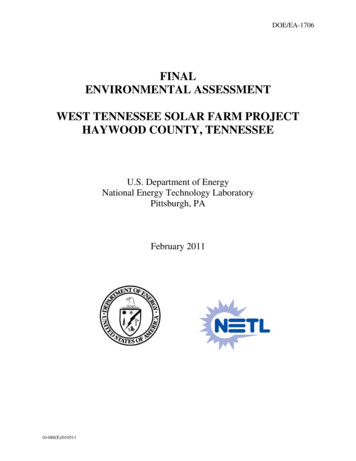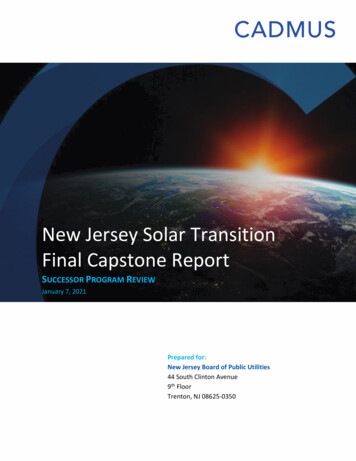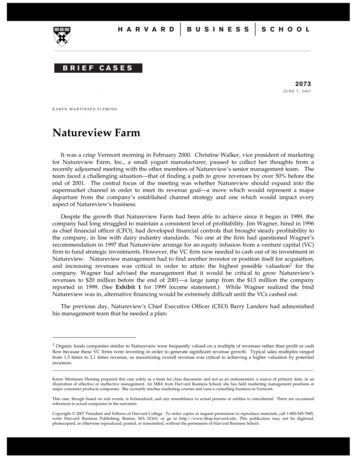
Transcription
DOE/EA-1706FINALENVIRONMENTAL ASSESSMENTWEST TENNESSEE SOLAR FARM PROJECTHAYWOOD COUNTY, TENNESSEEU.S. Department of EnergyNational Energy Technology LaboratoryPittsburgh, PAFebruary 201110-088(E)/010511
DOE/EA-1706FINALENVIRONMENTAL ASSESSMENTWest Tennessee Solar Farm ProjectHaywood County, TennesseeFebruary 201110-088(E)/010511
Environmental Assessment for the West Tennessee Solar Farm ProjectTable of Contents1INTRODUCTION . 11.1VOLUNTEER STATE SOLAR INITIATIVE . 11.1.1Tennessee Solar Institute . 11.1.1.1Solar Innovation Grants . 21.1.1.2Solar Installation Grants . 31.1.2West Tennessee Solar Farm . 31.2NATIONAL ENVIRONMENTAL POLICY ACT AND RELATED PROCEDURES. 41.3PURPOSE AND NEED FOR ACTION . 51.3.1DOE’s Purpose and Need . 51.3.2State of Tennessee’s Purpose and Need. 51.4SCOPE OF THIS ENVIRONMENTAL ASSESSMENT . 51.5PUBLIC INVOLVEMENT. 61.5.1Public Scoping . 61.5.2Draft EA Public Meeting and Comments . 81.6SUMMARY OF ENVIRONMENTAL EFFECTS . 92DESCRIPTION OF THE PROPOSED SOLAR FARM PROJECT AND ALTERNATIVES . 132.1PROPOSED SOLAR FARM PROJECT . 132.1.1Installation and Construction . 132.1.1.1Solar Farm . 132.1.1.2Electrical Interconnection . 152.1.1.3Information and Welcome Center . 172.1.2Operations . 172.1.2.1Solar Farm . 172.1.2.2Information and Welcome Center . 172.1.3Educational Programs . 182.2NO ACTION ALTERNATIVE . 182.3ALTERNATIVES CONSIDERED BUT ELIMINATED . 183AFFECTED ENVIRONMENT AND ENVIRONMENTAL CONSEQUENCES . 213.1INTRODUCTION. 213.2LAND USE AND VISUAL RESOURCES . 213.2.1Affected Environment. 213.2.2Environmental Consequences . 223.2.2.1Proposed Solar Farm Project . 223.2.2.2No Action Alternative . 223.3AIR QUALITY . 223.3.1Affected Environment. 223.3.2Environmental Consequences . 233.3.2.1Proposed Solar Farm Project . 243.3.2.2No Action Alternative . 273.4NOISE . 273.4.1Affected Environment. 273.4.2Environmental Consequences . 273.4.2.1Proposed Solar Farm Project . 283.4.2.2No Action Alternative . 293.5GEOLOGY AND SOILS . 293.5.1Affected Environment. 293.5.2Environmental Consequences . 313.5.2.1Proposed Solar Farm Project . 31Table of Contentsi
Environmental Assessment for the West Tennessee Solar Farm Project3.63.73.83.93.103.113.123.133.1443.5.2.2No Action Alternative . 32WATER RESOURCES . 323.6.1Affected Environment. 323.6.2Environmental Consequences . 343.6.2.1Proposed Solar Farm Project . 343.6.2.2No Action Alternative . 36BIOLOGICAL RESOURCES . 373.7.2Affected Environment. 373.7.2Environmental Consequences . 373.7.2.1Proposed Solar Farm Project . 373.7.2.2No Action Alternative . 38CULTURAL RESOURCES . 383.8.1Affected Environment. 383.8.2Environmental Consequences . 393.8.2.1Proposed Solar Farm Project . 393.8.2.2No Action Alternative . 39SOCIOECONOMICS AND ENVIRONMENTAL JUSTICE. 393.9.1Affected Environment. 393.9.2Environmental Consequences . 413.9.2.1Proposed Solar Farm Project . 413.9.2.2No Action Alternative . 42UTILITIES . 423.10.1Affected Environment. 423.10.2Environmental Consequences . 423.10.2.1 Proposed Solar Farm Project . 423.10.2.2 No Action Alternative . 44TRANSPORTATION . 443.11.1Affected Environment. 443.11.2Environmental Consequences . 453.11.2.1 Proposed Solar Farm Project . 453.11.2.2 No Action Alternative . 46WASTE MANAGEMENT . 463.12.1Affected Environment. 463.12.2Environmental Consequences . 473.12.2.1 Proposed Solar Farm Project . 473.12.2.2 No Action Alternative . 48PUBLIC AND OCCUPATIONAL HEALTH AND SAFETY . 483.13.1Affected Environment. 493.13.2Environmental Consequences . 493.13.2.1 Proposed Solar Farm Project . 493.13.2.2 No Action Alternative . 49INTENTIONAL DESTRUCTIVE ACTS . 49CUMULATIVE IMPACTS . 514.1LAND USE AND VISUAL RESOURCES . 524.2AIR QUALITY . 524.3NOISE . 534.4GEOLOGY AND SOILS . 534.5WATER RESOURCES . 534.6BIOLOGICAL RESOURCES . 534.7SOCIOECONOMICS AND ENVIRONMENTAL JUSTICE. 544.8UTILITIES . 554.9TRANSPORTATION . 55Table of Contentsii
Environmental Assessment for the West Tennessee Solar Farm Project5LIST OF AGENCIES AND PERSONS CONTACTED. 576LIST OF PREPARERS . 597REFERENCES . 61DISTRIBUTION LIST . 144AppendicesAppendix AConsultations and Coordination . 65Appendix BPublic and Agency Comments and Responses . 117List of FiguresFigure 1–1.Location of Proposed West Tennessee Solar Farm . 4Figure 2–1.Conceptual Site Layout of Solar Farm and Information Welcome Center . 14Figure 2–2.Electrical Interconnection Routes Evaluated in System Impact Study . 16Figure 3–1.Project Site . 21Figure 3–2.Streams and Ecological Areas . 33Figure 3–3.Transportation Routes . 44Figure 4–1.Proximity of the Solar Farm and Information and Welcome Center Project Site to theWest Tennessee Megasite. 51List of TablesTable 3–1.Haywood County Baseline Emissions. 23Table 3–2.Installation and Construction Emissions . 24Table 3–3.Operational Emissions . 25Table 3–4.Maximum Noise Levels at 50 Feet for Common Construction Equipment . 28Table 3–5.Noise Levels at Specific Distances from the Construction Site . 28Table 3–6.Acreage of Farmland and Farming Trends in Haywood County, Tennessee . 30Table 3–7.Selected Characteristics of Streams at Project Site . 33Table 3–8.Wetland Impacts Summary . 36Table 3–9.Demographic and Economic Characteristics: Haywood and Fayette Counties,Tennessee . 40Table of Contentsiii
Environmental Assessment for the West Tennessee Solar Farm ProjectTable 3–10.Estimated Racial or Ethnic Distribution for Solar Farm Region of InfluencePopulation: 2008. 40Table 3–11.Levels of Service Classifications and Conditions . 45Table 3–12.Local Landfill Capacity . 47Table of Contentsiv
Environmental Assessment for the West Tennessee Solar Farm ProjectList of ECDFARFHWAFPPAFRgpdGHGI-40“Interim PANRCSNRHPO&MORNLOSHAP.L.PVRCRARFPROIROWSEPSolar FarmSTEMCTDECTDOTTEMATable of ContentsAverage Annual Daily TrafficAir Conformity Applicability Modelaluminum conductor steel reinforcedAquatic Resources Alteration PermitAmerican Recovery and Reinvestment Actbest management practiceChickasaw Electric CooperativeCouncil on Environmental QualityCode of Federal Regulationscarbon dioxideDecibelU.S. Department of Energyenvironmental assessmentEconomic and Community Developmentforestry, agriculture and residentialFederal Highway AdministrationFederal Farmland Protection Policy ActFederal Registergallons per daygreenhouse gasInterstate 40“Interim Guidance on Air Toxic Analysis in NEPA Documents”KilovoltKilowattequivalent noise level over an 8-hour periodmaximum noise levelLevel of Servicemillion gallons per dayMetropolitan Statistical AreaMobile Source Air ToxicsMegawattNational Ambient Air Quality StandardsNational Emissions InventoryNational Environmental Policy ActNatural Resources Conservation ServiceNational Register of Historic Placesoperation and maintenanceOak Ridge National LaboratoryOccupational Safety and Health AdministrationPublic LawPhotovoltaicResource Conservation and Recovery Actrequest for proposalregion of influenceright-of-wayState Energy ProgramWest Tennessee Solar FarmSouthwest Tennessee Electric Membership CorporationTennessee Department of Environment and ConservationTennessee Department of TransportationTennessee Emergency Management Agencyv
Environmental Assessment for the West Tennessee Solar Farm able of ContentsTennessee State Historic Preservation OfficeTennessee Solar InstituteTennessee Valley AuthorityU.S. Army Corps of EngineersUnited States CodeU.S. Department of AgricultureU.S. Environmental Protection AgencyUniversity of TennesseeUniversity of Tennessee Research Foundationvehicle miles traveledvi
Environmental Assessment for the West Tennessee Solar Farm Project1INTRODUCTIONOn February 17, 2009, President Obama signed the American Recovery and Reinvestment Act (ARRA)of 2009 (P.L. 111-5). The objectives of the ARRA are:(1) to preserve and create jobs and promote economic recovery; (2) to assist those most impactedby the recession; (3) to increase economic efficiency by spurring technological advances inscience and health; (4) to provide long-term economic benefits through investment intransportation, environmental protection, and other infrastructure; and (5) to stabilize state andlocal government budgets, in order to minimize or avoid reductions in essential services andcounterproductive state and local tax increases (DOE 2009).The ARRA appropriated funding for the U.S. Department of Energy (DOE) to award formula-basedgrants under the State Energy Program (SEP). The goals established for the SEP are: Increase energy efficiency to reduce energy costs and consumption for consumers, businesses,and government. Reduce reliance on imported energy. Improve the reliability of electricity and fuel supply and the delivery of energy services. Reduce the impacts of energy production and use on the environment (DOE 2009).In accordance with Title 10 of the Code of Federal Regulations (CFR), Section 600.6(b) and Part 420,eligibility for award to those applying for formula grant financial assistance under DOE’s SEP isrestricted to states, territories, and the District of Columbia (DOE 2009).On May 12, 2009, the State of Tennessee filed an application with DOE to use some of its SEP fundsappropriated under the ARRA to establish the Volunteer State Solar Initiative. This environmentalassessment (EA) was prepared in compliance with the National Environmental Policy Act (NEPA) of1969 (42 U.S.C. 4321 et seq.), which requires federal agencies to evaluate the potential impacts of theirproposed actions. The State of Tennessee prepared this EA for DOE review and approval.1.1 VOLUNTEER STATE SOLAR INITIATIVEThe Volunteer State Solar Initiative has two key components: the Tennessee Solar Institute (TSI) and theWest Tennessee Solar Farm (Solar Farm) project described below. This EA evaluates the installation andoperation of the Solar Farm component of the Volunteer State Solar Initiative and the construction andoperation of the Tennessee Department of Transportation (TDOT) Information and W
CEC Chickasaw Electric Cooperative CEQ Council on Environmental Quality CFR Code of Federal Regulations CO2 carbon dioxide dB Decibel DOE U.S. Department of Energy . accelerating the national solar transformation in a manner that will











